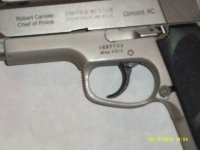Echo40
Member
- Joined
- Sep 25, 2017
- Messages
- 4,031
- Reaction score
- 7,821
What is the origin of the misconception that .40 S&W is a high pressure cartridge?
To this very day, folks make comments about .40 S&W being a high pressure cartridge, yet if you look at SAAMI Specs, .40 S&W is actually equal to Standard Pressure 9mm Luger, with both cartridges specified as 35,000psi. In other words, even 9mm Luger is potentially significantly higher pressure that .40 S&W due to 9mm Luger +P loads being 38,500psi. (There is no official +P loading for .40 S&W.)
The persistence of this misconception has endured for so long that I cannot help but wonder where exactly it came from and how it has lasted so long in spite of the fact that all it takes is a simple glance at SAAMI Specifications to see that it isn't accurate.
Was the .40 S&W at one point in time loaded hotter or what? As far as I know, it has always been loaded to 35,000psi in the United States, and it was actually loaded quite a bit lighter in Europe at 32,600psi according to C.I.P. Specifications.
So what precisely is the basis for the enduring misconception that .40 S&W is a high pressure cartridge?
To this very day, folks make comments about .40 S&W being a high pressure cartridge, yet if you look at SAAMI Specs, .40 S&W is actually equal to Standard Pressure 9mm Luger, with both cartridges specified as 35,000psi. In other words, even 9mm Luger is potentially significantly higher pressure that .40 S&W due to 9mm Luger +P loads being 38,500psi. (There is no official +P loading for .40 S&W.)
The persistence of this misconception has endured for so long that I cannot help but wonder where exactly it came from and how it has lasted so long in spite of the fact that all it takes is a simple glance at SAAMI Specifications to see that it isn't accurate.
Was the .40 S&W at one point in time loaded hotter or what? As far as I know, it has always been loaded to 35,000psi in the United States, and it was actually loaded quite a bit lighter in Europe at 32,600psi according to C.I.P. Specifications.
So what precisely is the basis for the enduring misconception that .40 S&W is a high pressure cartridge?

